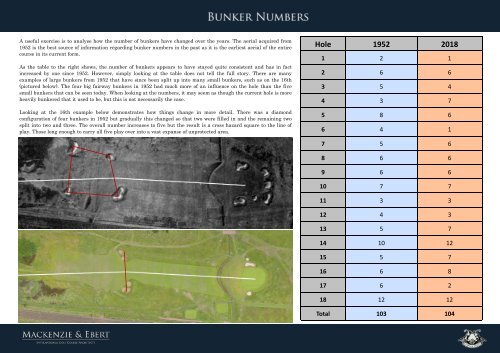You also want an ePaper? Increase the reach of your titles
YUMPU automatically turns print PDFs into web optimized ePapers that Google loves.
A useful exercise is to analyse how the number of bunkers have changed over the years. The aerial acquired from<br />
1952 is the best source of information regarding bunker numbers in the past as it is the earliest aerial of the entire<br />
course in its current form.<br />
As the table to the right shows, the number of bunkers appears to have stayed quite consistent and has in fact<br />
increased by one since 1952. However, simply looking at the table does not tell the full story. There are many<br />
examples of large bunkers from 1952 that have since been split up into many small bunkers, such as on the 16th<br />
(pictured below). The four big fairway bunkers in 1952 had much more of an influence on the hole than the five<br />
small bunkers that can be seen today. When looking at the numbers, it may seem as though the current hole is more<br />
heavily bunkered that it used to be, but this is not necessarily the case.<br />
Looking at the 16th example below demonstrates how things change in more detail. There was a diamond<br />
configuration of four bunkers in 1952 but gradually this changed so that two were filled in and the remaining two<br />
split into two and three. The overall number increases to five but the result is a cross hazard square to the line of<br />
play. Those long enough to carry all five play over into a vast expanse of unprotected area.<br />
Hole 1952 2018<br />
1 2 1<br />
2 6 6<br />
3 5 4<br />
4 3 7<br />
5 8 6<br />
6 4 1<br />
7 5 6<br />
8 6 6<br />
9 6 6<br />
10 7 7<br />
11 3 3<br />
12 4 3<br />
13 5 7<br />
14 10 12<br />
15 5 7<br />
16 6 8<br />
17 6 2<br />
18 12 12<br />
Total 103 104


